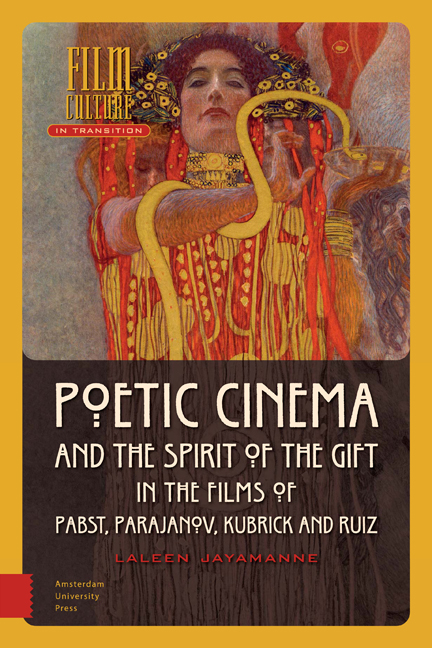Book contents
- Frontmatter
- Dedication
- Contents
- Foreword: In Memory of Thomas Elsaesser
- Introduction: Spirit of the Gift: Cinematic Reciprocity
- 1 A Gift Economy: G. W. Pabst’s Pandora’s Box (1929)
- 2 Fabric of Thought: Sergei Parajanov
- 3 Nicole Kidman in Blue Light: Stanley Kubrick’s Eyes Wide Shut (1999)
- 4 Ornamentation and Pathology: Raúl Ruiz’s Klimt (2006)
- Afterword: Poetics of Film Pedagogy
- Bibliography
- Filmography
- About the Author
- Index
Introduction: Spirit of the Gift: Cinematic Reciprocity
Published online by Cambridge University Press: 13 April 2021
- Frontmatter
- Dedication
- Contents
- Foreword: In Memory of Thomas Elsaesser
- Introduction: Spirit of the Gift: Cinematic Reciprocity
- 1 A Gift Economy: G. W. Pabst’s Pandora’s Box (1929)
- 2 Fabric of Thought: Sergei Parajanov
- 3 Nicole Kidman in Blue Light: Stanley Kubrick’s Eyes Wide Shut (1999)
- 4 Ornamentation and Pathology: Raúl Ruiz’s Klimt (2006)
- Afterword: Poetics of Film Pedagogy
- Bibliography
- Filmography
- About the Author
- Index
Summary
I have already said this before: cinema is condemned to be poetic. It cannot but be poetic. One cannot ignore this aspect of its nature. For poetry will be there, within our reach. If so, then why not use it?
Each of the four chapters of this book is dedicated to a film or two by a master film-maker. They span the period from the silent film Pandora's Box (1929) by G. W. Pabst, to a late film by Raul Ruiz, Klimt (2006). In between, I explore two celebrated films by Sergei Parajanov – The Color of Pomegranates (1969) and Ashik Kerib (1988) – and the critically maligned last film of Stanley Kubrick, Eyes Wide Shut (1999). The oblique mode of address of each of these films makes it possible to think of them as poetic. A basic assumption that governs my film criticism here is the thought that the image is prior to the narrative and gives rise to it. As Ruiz says, ‘In all narrative films – and all films are so to an extent – it is the image that determines the type of narration and not the contrary’. As a result, the image has an aesthetic richness, a magnetic force irreducible to the narrative line. In these films, the image may even show something that does not coincide with narrative meaning. Such moments make the image poetic, mysterious, unforgettable. It may even pose ‘inexplicable enigmas’, as Ruiz would have it. If only we yield to them, all of these qualities generate unique cinematic emotions and thought. Gilles Deleuze supports the view that film, in its very ontology, is an image in movement, which generates the narrative. For him, too, the image and its powers are primary.
The kinaesthetic and proprioceptive sensations stimulated by these films are especially powerful in the silent film Pandora's Box, because Louise Brooks, the star, was primarily a trained modern dancer. Silent cinema had achieved an astonishing level of aesthetic sophistication, abstraction, and plasticity of the image within a few short decades by the time it was made obsolete in 1929 with the arrival of sound.
- Type
- Chapter
- Information
- Poetic Cinema and the Spirit of the Gift in the Films of Pabst, Parajanov, Kubrick and Ruiz , pp. 13 - 22Publisher: Amsterdam University PressPrint publication year: 2021



